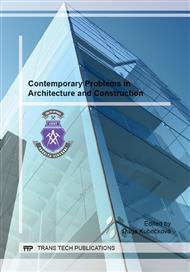p.37
p.43
p.49
p.55
p.60
p.66
p.71
p.76
p.80
Technological Processes in Natural Stone Processing with Recommendations of Processing Tools Evaluation
Abstract:
The processing of surface of stone elements, as a result of which they are getting the relevant texture and the surface quality, is one of main requirements in the masonry production. As a result of finishing processing in the process of grinding, the surfaces should have a regular appearance of the surface.They should conform to certain requirements of norms on all exposed surfaces. This process can be conducted with grinders: knee, arterial or bridge. These machines are working with so-called heads equipped with abrasive fillers in the form of sections about different geometrical shapes fixed to the processing head which is a so-called load-bearing shield. Ensuring the appropriate quality, smoothness of mineral surface is significant for: - receiving required physical and mechanical parameters what has the significant influence on the operating period and running costs associated with it, - keeping the purity of the surface, what reduce the time of cleaning i.e. maintenance of the object, - utrzymania czystości powierzchni, co zmniejsza czas sprzątania tzn. utrzymania obiektu, - aesthetic and architectural adventages. Providing the high quality for the surface is depending on effectiveness of the influence of operating units which they comprise i.a. geometrical form of so-called rubbing sections. The article is devoted to the methodology of the evaluation of effectiveness of the processing which among others rubbing geometry tools determines.
Info:
Periodical:
Pages:
60-65
Citation:
Online since:
October 2014
Authors:
Price:
Сopyright:
© 2014 Trans Tech Publications Ltd. All Rights Reserved
Share:
Citation:


